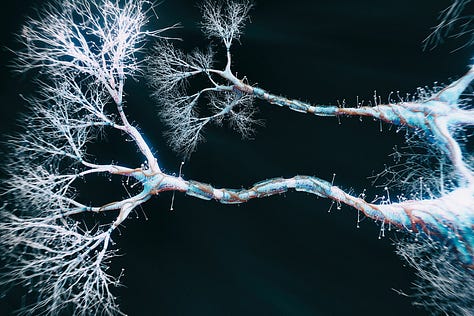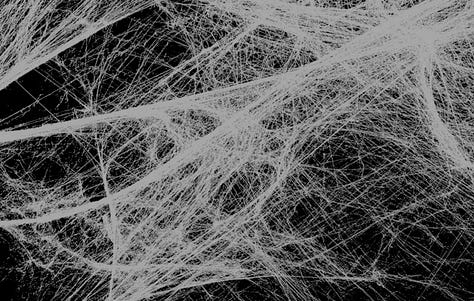Grounded Expansion: The Cybernetic Dance of Mind, Body, and Vision
A Blueprint for Mind-Body Feedback and Multidimensional Growth



The Art of Grounded Expansion
We live in a world that constantly pushes us to expand—dream bigger, move faster, and become more. And while the desire to step into new possibilities is beautiful, it’s also where many of us get stuck. Often, we don’t realize that what holds us back isn’t just fear or overwhelm. It’s the unconscious patterns—deeply ingrained in our minds and bodies—that silently shape our behaviors. These patterns are often rooted in trauma, generational cycles, and societal conditioning.
For years, many of us move through life unaware of the trauma responses that steer our actions. We might think we’re stuck because we’re not trying hard enough, not pushing ourselves enough. But in reality, we’re trapped in cycles of fight, flight, or freeze that we don’t even know we’re in. We suppress our emotions, disconnect from our bodies, and bury our needs deep down, thinking that if we just do more, achieve more, we’ll finally be okay.
But what we don’t see is that without learning to communicate with ourselves—without understanding our body’s signals, the emotions we’re carrying, or the generational trauma that weighs on us—our expansion will always be limited. We either burn out from pushing too hard, or we freeze, unable to move forward because our bodies are stuck in a survival state.
Here’s the truth: our fullest expansion can only happen when we first stabilize. When we build a foundation of safety in the present moment, we create the capacity to truly hear our inner selves—our emotions, our bodies, our needs—and expand from a place of calm, not chaos. This is the dance between stability and expansion. We create stability by learning to regulate our nervous system, process our emotions, and listen to the feedback our mind-body system is constantly offering.
Only then can we expand, not just into the life we want, but into the life we’re truly ready for.
My Journey to Harmony: The Power of Stability Before Expansion
For most of my life, if you’d asked me whether I’d experienced trauma, I would have said no, absolutely not. I was fortunate—no physical or sexual abuse, no major traumas by the typical definition. But as I deepened my education, became trauma-informed and somatic-aware, I started to understand the subtle layers of trauma we’re all swimming in. Trauma isn’t just catastrophic events; it’s any emotion, experience, or event that is too much, too fast, too soon for our nervous systems to process.
Take, for instance, a child who raises their hand in class, eager to answer a question, only to get it wrong. The teacher brushes them off, or worse, their classmates laugh. In that moment, a deep imprint is formed—not just embarrassment, but a sense of “I’m not smart enough,” or “I should just stay quiet.” Without the tools to process that emotion, the child may unconsciously decide that it’s safer to stay small, to avoid being seen, or to never risk making a mistake again. As an adult, this same person might find themselves holding back in meetings, not sharing their ideas, or self-sabotaging just before a big opportunity. What looks like ‘imposter syndrome’ today may have roots in that childhood moment—an unprocessed emotion, a tiny seed of doubt that’s grown over the years into a full-blown limiting belief, quietly steering their behavior without them even knowing.
Looking back now, I can see how for years, I—like so many men I know—was disconnected from my inner world. I had no internal communication skills to understand my emotions or process my feelings. We’re taught to suppress them, and without realizing it, I was living a life completely disconnected from my authentic self. I was externally motivated, driven by the need to hustle, grind, provide, and succeed. It felt like constant expansion, but it was really a trap. I wasn’t expanding toward my potential; I was stuck in a cycle of burnout and plateau because I had no foundation of stability.
It wasn’t until I started to understand the importance of nervous system regulation—how to relax, how to make sense of and process emotions and release stored tension—that I began to see a shift. Meeting Ganga Devi, learning how to decompress in simple ways, like being in the garden with nothing to do, no one to be, was a revelation. As a meditation instructor with a background in physiology, I already understood the parasympathetic nervous system in theory, but it took practice to learn how to actually activate it, how to increase my range of tolerance, and metabolize my emotions and past experiences.
From that place of stability, I could finally expand—intentionally, without burning out. I could tap into my vision, move through life with purpose, and then drop back into a stabilized state to recover and realign. It’s not just expansion; it’s undulated infinite growth, while remaining grounded and in harmony in the present. This dynamic harmony between stability and expansion has no limits, and it’s what has allowed me to reach a level of fulfillment and growth I never thought possible.
The beauty of the mind-body system is that it’s constantly giving us feedback. When we learn to listen, stabilize, and expand from there, we can create a future that feels not just possible—but sustainable.



Psycho~Somatic~Cybernetics: Understanding the Mind-Body Feedback Loop
What is Psycho~Somatic~Cybernetics?
Many people hear the word “psychosomatic” and immediately think of it as something negative or dismissive—like it’s “all in your head.” But that’s a misunderstanding. In reality, the term reflects the beautifully interconnected system of mind (psycho) and body (somatic) that’s constantly responding to our internal and external environments.
Building on the works of Norbert Weiner and Maxwell Maltz (more about them in the Further Exploration section), Ganga Devi and I have developed Psycho~Somatic~Cybernetics as a core methodology of our approach. It goes a step further by introducing the idea of cybernetics: the science of communication and control systems in living organisms. In simple terms, it’s the feedback loop between our thoughts, emotions, physical sensations, and the environments we interact with. Everything is connected. Our mind influences our body, and our body, in turn, influences our mind. This is not a one-way street, but a dynamic dance between the two.
Mind-Body Feedback: How It Works
Our thoughts and emotions (psycho) and physical sensations (somatic) are always creating feedback loops—guiding how we respond to stress, navigate challenges, and make decisions. Just as our bodies react to our emotions (think of how you might tense up when stressed), our emotions also respond to physical states. This means that healing, growth, and expansion require paying attention to both.
For example, unresolved trauma often gets stored in the body. Trauma doesn’t have to be a dramatic event; it can be any experience that’s too much, too fast, or too soon for our nervous system to process. When this happens, we go into survival states—fight, flight, or freeze. These are our body’s beautiful defense mechanisms, designed to keep us safe. But over time, if these traumas remain unprocessed, we can get stuck in those survival patterns, even when we’re no longer in danger.
Learning to thank our bodies for keeping us safe is the first step to healing. These patterns aren’t our enemies—they’re our body’s way of protecting us. But to expand beyond them, we need to learn how to communicate with our bodies and regulate our nervous systems, so we can process these experiences and move forward.
The Power of Somatic Practices
A client of mine was initially skeptical about the mind-body connection. We worked on integrating breathwork with a clear vision—aligning his breath, body, and intention to see what impact it could have on his performance. Before his next workout, he focused on his breathing and set a simple but powerful intention: to feel strong and fluid as he lifted.
When he went to lift a weight that usually felt heavy, he was surprised. The weight felt light. He moved with control and ease, unlike anything he had experienced before.
He laughed and said, “It’s probably just psychosomatic.” And I said, “Exactly—that’s my entire point!”
What he experienced wasn’t just in his head—it was the feedback loop between his mind, body, and vision working in harmony. By combining breath and intention, he tapped into a deeper connection, one that made his movements more efficient and his strength more accessible.
What’s often dismissed as “just psychosomatic” is actually the key to unlocking our full potential. The feedback loop between the mind and body isn’t a weakness; it’s our greatest tool for realignment and growth. By learning how to listen to this feedback, we gain the ability to course-correct when needed, stabilize our emotions and physical states, and then expand into new levels of performance and possibility.
What’s dismissed as ‘just psychosomatic’ is the key to unlocking our potential. The mind-body connection is the feedback loop that helps us course-correct, realign, and expand.
Stabilize & Expand: The Dance of Growth and Transformation
Stabilizing in the Present Moment
The first step in regenerative growth is stabilization. When we stabilize, we create the internal safety necessary for expansion. This means calming our nervous system and accessing the parasympathetic state, where we’re no longer stuck in survival mode. In that place of stability, we can finally breathe, relax, and open ourselves to new possibilities.
In today’s world, hyperarousal is the norm. Whether it’s the relentless hustle culture, social pressures, or constant distractions, we’re often in a state of overdrive, locked in a red-light reflex—a state of rigid fight-or-flight posture. This keeps us stuck in survival mode, where we’re reactive rather than creative. Without stabilization, we limit our ability to think expansively or move forward in a grounded way.
Expansion as the Next Step
Once we’ve built a foundation of stability, we can begin to expand. Expansion is the process of broadening our range of tolerance—both physically, emotionally, and mentally. But it doesn’t mean pushing ourselves too far, too fast. Expansion happens when we stretch our boundaries just enough while knowing we have the safety of our stabilized state to return to. This is how we thrive across multiple dimensions of life.
From my experience as a coach, I’ve seen how this works in many areas of life. Whether it’s pushing physical boundaries in fitness, expanding emotional vulnerability in relationships, or envisioning a bigger future for yourself, authentic expansion happens when you’ve stabilized your foundation. Without stability, we risk burning out, crashing, or retreating. But with dynamic harmony between stabilization and expansion, we can stretch ourselves, explore new possibilities, and thrive.
Visioning and Periodization
A critical part of expansion is visioning—mapping out what we want our future to look like. Once stabilized, we can create space for visioning our highest potential, using visualization and affirmations to anchor this future. This is where the cybernetic feedback loop becomes essential again. By setting a clear vision, we activate the mind-body system to align our actions and emotions with that vision.
This visioning process ties directly into the idea of periodization. In fitness, periodization is about breaking down large goals into manageable phases. Similarly, with expansion, we can use periodization to break down our larger vision into daily, weekly, and monthly inputs. This allows us to expand in a sustainable and intentional way—stretching, recovering, and growing without overloading ourselves.
Stability and Expansion in Harmony
The process of stabilization and expansion isn’t a linear path—it follows more of a spiral, where we return to the center, recalibrate, and then move outward again. This dynamic interplay anchors us in the present while allowing us to stretch toward new possibilities. As we’ve explored, this requires tuning into the feedback loops of Psycho~Somatic~Cybernetics, regulating our nervous system, and setting clear visions for where we want to go. Stability gives us the foundation to expand, and expansion allows us to thrive across all dimensions of life.
By aligning this balance, we don’t just grow—we thrive. And this thriving isn’t just about personal achievement; it’s about expanding into our fullest selves, contributing to the collective, and living a life of intentional, multidimensional growth.
The dynamic harmony between stabilizing in the present and expanding into the future is where life thrives. This is the foundation of multidimensional growth.
Embodied Visioning Practice: Stabilizing and Expanding Into Your Future
As you reflect on today’s message, take a moment to think about a future state you want to expand into. This could be something that feels far away, like 10 years into the future, or something closer, like a month, a week, or even tomorrow. Perhaps it’s an upcoming trip, event or birthday, or simply a state of being you desire.
Once you have that future state in mind, let’s integrate it into the body with a breathwork and visualization practice designed to stabilize your system and anchor your vision.
Homing Breath Practice (click here for full instructions)
Find a comfortable position. You can sit or lie down—whatever allows you to relax and feel supported.
Place one hand on your heart and one on your stomach. Feel the warmth of your hands and the connection to your body.
Breathe deeply through your mouth, allowing your diaphragm to expand fully. As you breathe in, feel the breath move into your stomach. Allow your jaw to remain open and relaxed.
Exhale with a soft sigh, making the sound “Ahhhhh” as you release the breath. Let the sound help you relax even further, calming your nervous system. Continue this breath for a few more rounds, feeling your body stabilize and settle.
Guided Vision and Embodiment Practice
Once you feel grounded and your breath is flowing smoothly, close your eyes if that feels good for you. And you’ll begin the visualization.
Bring to mind your future state—whether it’s a moment in time, an achievement, or a personal milestone. Picture it clearly.
Use your senses to explore this vision. What does it look like? Who’s with you? What colors and shapes surround you? Now go deeper—what do you hear? Maybe there are voices, music, or even nature sounds.
What do you feel in your body as you stand in this future state? Notice how your chest feels, how your legs feel rooted to the ground. Feel the energy moving through you—strong, calm, and steady.
As you continue to breathe, imagine what it smells like and what it tastes like. Perhaps there’s a favorite meal involved or the scent of nature around you. Let every sense participate in this moment, making it as real as possible.
Finally, feel the emotions. How does it feel to be fully in this moment, fully expanded and grounded in your future self? Does it feel joyful, peaceful, powerful?
Spend a few more moments here, letting your body soak in the sensations and emotions of this vision.
Integration and Reflection
Take deep breath in, allowing yourself to fully integrate the sensations and emotions of your future vision. Hold it for a moment, and as you exhale slowly, let any tension melt away.
Now ask yourself: How do you feel? Has the Homing Breath helped you create a stable foundation to anchor this vision? How does it feel in your body now—closer, more achievable, more grounded in reality?
You’re invited to write down your thoughts. Consider how this practice stabilized you in the present and gave you a clearer path toward your future. What’s one step you can take today to move toward that vision, knowing that you can always return to this stable, grounded space whenever you need?
As you move forward, remember that stability is always within reach, no matter how far you expand. Return to your breath, to your body, and to this grounded space whenever you need. From here, your vision can grow with clarity and purpose.
Reclaiming Stability in a Chaotic World: Society, Trauma, and the Path to Expansion
Society often pushes us to expand too quickly, without equipping us with the tools for true stability. Whether it’s through work culture, social media comparison, or the relentless pressure to achieve, we are constantly encouraged to grow, scale, and “level up”—but at what cost? This constant demand for expansion without stabilization leads to burnout, collapse, or retreat. Even when we achieve what we think will make us happy, there still isn’t fulfillment—there’s always the next thing.
Think about how often we’re asked to stretch ourselves without considering whether our foundation is stable. We’re taught to push through discomfort, to override our exhaustion, and to keep going until we reach the next goal. But regenerative growth requires more than just pushing. It requires a balance. A dynamic dance between stability and expansion.
Expansion, in the fullest sense, isn’t about constant forward motion. It’s about knowing when to pause, when to recalibrate, and when to come back to the center. This is something that society doesn’t teach us. But it’s something we must reclaim if we are to thrive. By learning to stabilize ourselves first, we create the capacity for authentic expansion—growth that doesn’t come at the expense of our well-being.
As we envision the future, we must ask ourselves: What kind of society do we want to build? One that perpetuates trauma cycles, or one that allows space for stability, healing, and regenerative expansion? When we choose the latter, we are not just healing ourselves; we are contributing to the healing of society as a whole.
Healing from trauma isn’t just personal—it’s collective. By stabilizing ourselves, we expand our capacity to heal societal wounds and build a future where all of us can thrive.
Further Exploration: Regenerative Practices for Long-Term Growth
As we deepen our journey into the interplay of mind-body connection, trauma healing, and authentic expansion, it’s essential to turn to resources that expand our understanding and offer practical tools. Below are a few transformative books that provide insights into somatic healing, cybernetics, emotional growth, and the feedback loops that guide our development. Whether you’re looking to heal, grow, or simply explore further, these resources will support you on your path.
Books and Resources:
The Body Keeps the Score by Bessel van der Kolk
A foundational book on trauma and somatic healing, van der Kolk explains how trauma is stored in the body and offers insights into reclaiming physical and emotional well-being through practices that reconnect the mind and body.
The Wisdom of Your Body: Finding Healing, Wholeness, and Connection through Embodied Living by Hillary L. McBride
McBride explores how societal conditioning disconnects us from our body’s innate wisdom. She provides practical insights on healing emotionally by reconnecting with the body, offering tools for embracing embodied living and cultivating holistic well-being.
Nonviolent Communication by Marshall Rosenberg
An essential guide to emotional expansion and boundary work, Rosenberg teaches readers how to communicate authentically and empathetically, strengthening relationships with ourselves and others through nonviolent communication practices.
Psycho-Cybernetics by Maxwell Maltz
A classic on self-image psychology, Maltz outlines how visualizing desired outcomes can rewire our brain and transform our lives. His work emphasizes the mind-body feedback loop and how it can be harnessed for growth and self-development.
Cybernetics and Human Knowing by Norbert Wiener
A deep dive into the science of cybernetics and systems thinking, Wiener’s work explores feedback loops in living organisms. His insights can guide us in understanding and leveraging the mind-body connection for personal growth. Here is a link to an incredibly fascinating segment profiling the work of Wiener—comment if you want to nerd out on it with me!
Inner Work Reflection: Building Stability for Expansion
As you reflect on today’s exploration of stability and expansion, take a moment to tune in to your own body’s signals. Where in your life are you feeling overstretched or ungrounded? Is there a part of your life—whether it’s your work, relationships, or personal growth—that’s asking for recalibration before you push forward?
Ask yourself:
“How does my body let me know it’s time to slow down and stabilize?”
“Where can I focus on grounding myself before expanding further?”
These small moments of self-awareness are where transformation begins. By taking time to stabilize, you create the foundation for authentic, sustainable growth in every area of your life.
Stabilizing in Practice: What Does It Look Like?
Stabilization isn’t just a concept—it’s something we can practice daily to create a foundation of calm, resilience, and balance. Here are some tangible ways to bring stabilization into your life:
Mindful Breathing: Taking intentional, deep breaths throughout the day can calm the nervous system and help bring you back into the present moment. Mindful breathing is about coming home to your body, reconnecting with your true essence. It’s a reminder that beneath the stress and noise, there’s a calm state of just being—your natural state. By grounding yourself in breath, you’re giving your body permission to relax and return to this place of calm whenever you need. (Steps to Homing Breath Here)
Body Awareness & Movement: Create a habit of moving your body throughout the day with breath and intention. Focus on gentle, rhythmic movements—whether it’s rotating your spine, flowing your arms, or moving your hips—that allow you to feel present in the flow. These movements don’t have to be intense; the goal is to remain connected to your body’s natural rhythms, using movement as a tool to stay grounded, fluid, and present.
Meeting Sensory Needs: Meeting your sensory needs is key to grounding yourself in the present. This can be as simple as enjoying a warm cup of tea, wearing something soft against your skin, or savoring a moment of stillness. Think about how you can meet your sensory needs throughout the day—whether it’s adjusting the temperature in your space, drinking something satisfying, or listening to playlists for the right mood. The goal is to create an environment that supports your well-being, helping you feel more grounded and nourished.
Feeling Called to Go Deeper?
If today’s message resonated with you, and you’re ready to go deeper into this work, I’m here to support you. Whether you’re feeling stuck or seeking clarity on your next steps, together we can create a plan that honors your need for stability while guiding you toward intentional expansion. Let’s build your multidimensional growth from the inside out.
Deep Roots, Endless Growth: The Tree’s Wisdom of Stability and Expansion
Imagine you are a tree—rooted deep in the earth, reaching up toward the sky. But a tree’s journey isn’t just about standing tall. It’s about flowing with the cycles of life. Every year, you go through seasons of blossoming, fruiting, shedding, and resting. In the spring, your branches bloom with flowers and fruit, signaling growth and expansion. But as autumn arrives, those same branches release their leaves, shedding what is no longer needed. And in the winter, you stand bare, conserving your energy, waiting for the cycle to begin again.
Each part of this cycle is essential. The shedding is not loss, it’s regeneration. The resting is not stagnation, it’s preparation. And the growth? It’s sustainable only because of the rooted stability beneath the surface. Without deep roots, your branches might stretch too far, leaving you vulnerable to life’s storms. But with grounded roots, you can endure those storms, knowing they are part of the dance between stability and expansion.
This mirrors our own cycles of growth. Trauma, like those storms, might shake us, but it’s also a part of the cycle, something that, when processed and released, allows us to regenerate. Psycho~Somatic~Cybernetics teaches us that our bodies and minds are interconnected, constantly communicating through feedback loops. These feedback loops allow us to stabilize when needed, and from that place of stability, to expand into new realms—just like the tree, growing with each season yet always rooted.
May you honor every cycle of your life—the blossoming, the shedding, and the quiet stillness that prepares you for rebirth.
May you root deeply in your essence, knowing that your expansion is infinite when it flows in harmony from a place of stability. Just as the tree’s branches reach for the sky, nourished by the soil and guided by the seasons, honor the light that nourishes your growth, the love that flows through you like sap, and the perfection that resides within, connecting you to all living things.







I am probably not ready to nerd out about Norbert Wiener quite yet, but I am willing to engage in the conversation to better understand what resonated about the video you shared. What do you feel has aged well and still feels relevant? The examples of feedback in the relational scenarios as they were dramatized do communicate the basic idea of how navigating must take in the entire system, rather than focusing only on individual actions as a linear series of cause and effect. Cybernetics, must take in the complexity of the whole environment. Finding flow might require small adjustments, moment by moment, to navigate a particular course. It seems that Psycho~Somatic~Cybernetics requires a greater awareness and presence to maintain a course.
To be more precise, I might be exploring these same themes, except in language that a child might be able to understand. In a children’s story that I am writing, the main character, Luna Solterra, is the metaphysical gravity that holds the celestial bodies together. Moon (Luna) is analogous to the heart. Sun (Sol) is analogous to the mind. Earth (Terra) is analogous to the body. Luna Solterra represents the awareness required to navigate the world as love by integrating the feelings of the heart, the thoughts of the mind, and the senses and actions of the body.
So, I am writing about the mind-heart-body connection, which I suppose could be expressed as Psycho~Cardio~Somatic~Cybernetics. In this story, Luna Solterra would be the navigator of this vessel. She would be the awareness of the senses (time), spirit (energy), and soul (matter)—the helmsperson represented by the word kybernetes.